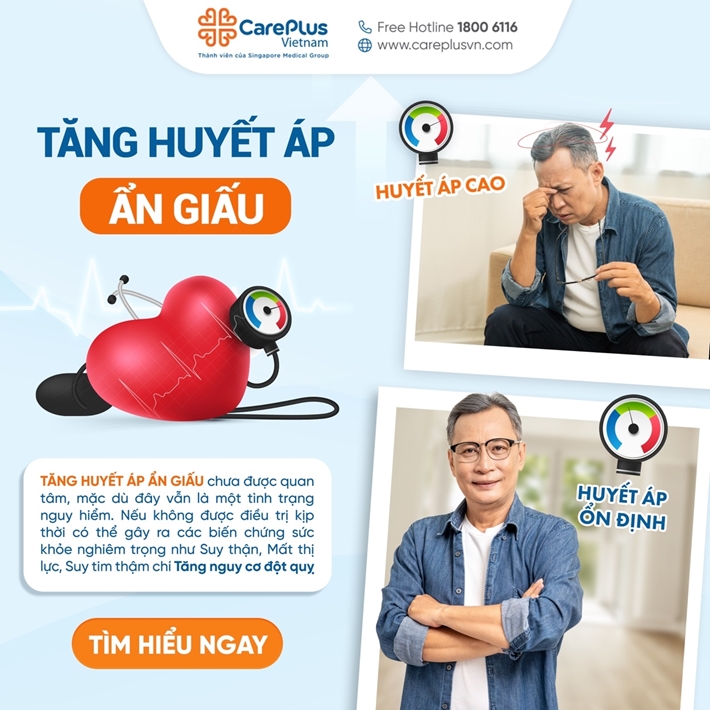MASKED HYPERTENSION
Masked hypertension refers to a condition where a patient’s blood pressure (BP) appears normal (below 140/90 mmHg) when measured in a clinical setting but exceeds the threshold of 135/85 mmHg when measured outside the clinic, such as at home or with ambulatory blood pressure monitoring (ABPM) over 24 hours. The concern with masked hypertension is that it often goes unnoticed, yet it poses significant health risks. If left untreated, it can lead to severe complications such as kidney failure, vision loss, heart failure, and an increased risk of stroke.

11/6/2024 11:59:25 AM
1. Causes of Masked Hypertension
The causes of masked hypertension are like those of regular hypertension and may include:
- Arterial dysfunction: Abnormalities in the arteries can increase pressure within the vessels, leading to hypertension.
- Physical inactivity: Lack of physical activity impairs the body’s ability to regulate blood pressure effectively.
- Stimulants: Substances such as caffeine, tobacco, and alcohol can raise blood pressure.
- Stress: Emotional or physical stress can cause temporary spikes in blood pressure.
- Side effects of medications: Some medications, such as monoamine oxidase inhibitors (MAOIs), antihistamines, or antidepressants, can contribute to elevated blood pressure.
- Underlying health conditions: Conditions like diabetes, kidney disease, and thyroid disorders are often associated with masked hypertension.
2. Diagnosis of Masked Hypertension
To detect masked hypertension, several approaches are recommended:
- Home blood pressure monitoring (HBPM): Patients are advised to measure their blood pressure at home, especially in the morning and evening, as guided by their healthcare provider. This provides a comprehensive view of BP variations throughout the day.
- 24-hour ambulatory blood pressure monitoring (ABPM): This method uses a portable device that measures BP continuously over 24 hours, capturing readings during daily activities and sleep to reveal hidden elevations.
3. Symptoms of Masked Hypertension
Symptoms of masked hypertension are often subtle or absent, but in some cases, patients may experience:
-
Headaches: Typically occurring at the back of the head and persisting regularly.
-
Fatigue: Persistent tiredness or discomfort may indicate elevated BP.
-
Dizziness: Sudden episodes of dizziness can result from high BP spikes.
-
Chest pain: Increased BP may cause chest pain due to pressure on the heart and blood vessels.
-
Shortness of breath: Breathlessness can occur as a result of elevated BP affecting cardiovascular function.
-
Nausea: High BP may cause nausea or digestive discomfort.
4. Complications of Masked Hypertension
Masked hypertension is a dangerous condition that can lead to serious health complications if not detected and treated early. Some potential complications include:
-
Cardiovascular disease: Masked hypertension increases the risk of coronary artery disease, heart failure, myocardial infarction, and brain infarcts.
-
Stroke: It is a significant risk factor for stroke, as unchecked BP elevations can damage cerebral arteries and lead to strokes.
-
Kidney failure: High BP can impair kidney function by damaging the small blood vessels within the kidneys.
-
Cataracts: Masked hypertension may raise the risk of cataracts, a condition that can impair vision.
-
Pregnancy complications: Masked hypertension in pregnant women can pose health risks to both the mother and the baby, increasing the likelihood of preeclampsia and other complications.
5. Treatment and Prevention
Treatment
The treatment of masked hypertension is similar to that of traditional hypertension and involves a combination of lifestyle changes and medications to maintain stable blood pressure:
Lifestyle modifications:
-
Adopt a low-sodium diet and reduce saturated fats.
-
Increase physical activity, aiming for at least 30 minutes of exercise daily.
-
Quit smoking and reduce alcohol consumption.
-
Manage stress through meditation, yoga, or relaxation techniques.
Medications:
Physicians may prescribe medications such as ACE inhibitors, beta-blockers, diuretics, or calcium channel blockers to help regulate blood pressure and prevent complications.
Prevention
- Regular BP monitoring: Individuals at high risk (e.g., older adults, smokers, diabetics, or those with lipid disorders) should regularly measure their blood pressure at home or undergo periodic ABPM to detect masked hypertension early.
- Routine health check-ups: Comprehensive medical evaluations can help identify other risk factors, such as diabetes, obesity, and dyslipidemia.
- Adherence to treatment: For those already diagnosed with hypertension, following medical advice and treatment plans is crucial for effective BP control.
Conclusion
Masked hypertension is a hidden health threat that is often missed during routine clinic visits. Patients, especially those at high risk, need to monitor their blood pressure regularly and comprehensively to ensure early detection. Without timely diagnosis and intervention, masked hypertension can significantly increase the risk of severe complications affecting the heart, kidneys, eyes, and brain. Early treatment and lifestyle adjustments are key to managing this condition, improving quality of life, and preventing dangerous health outcomes.